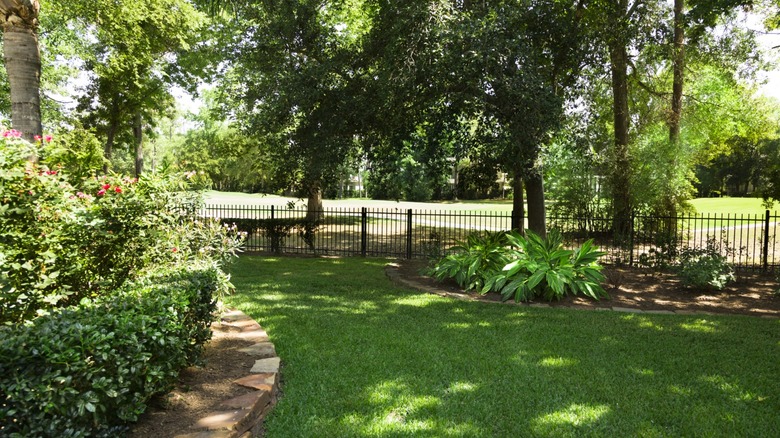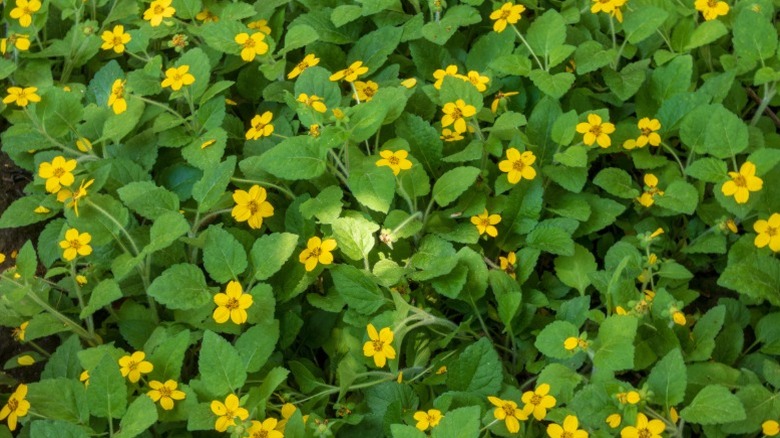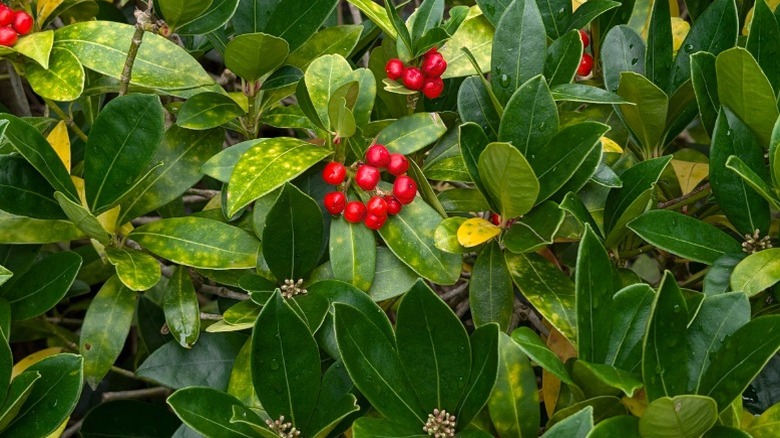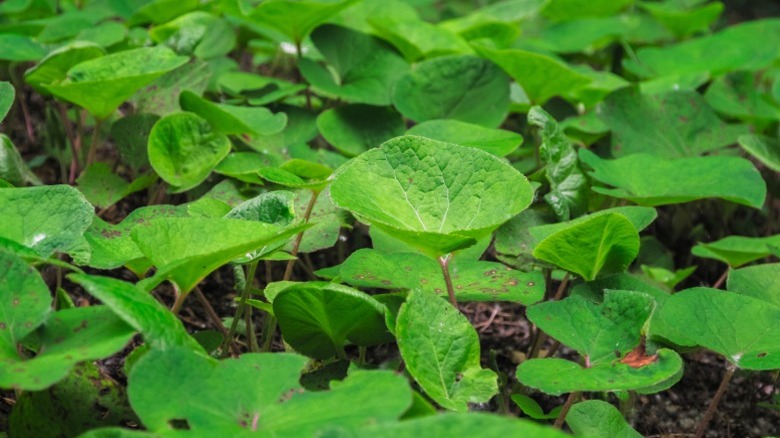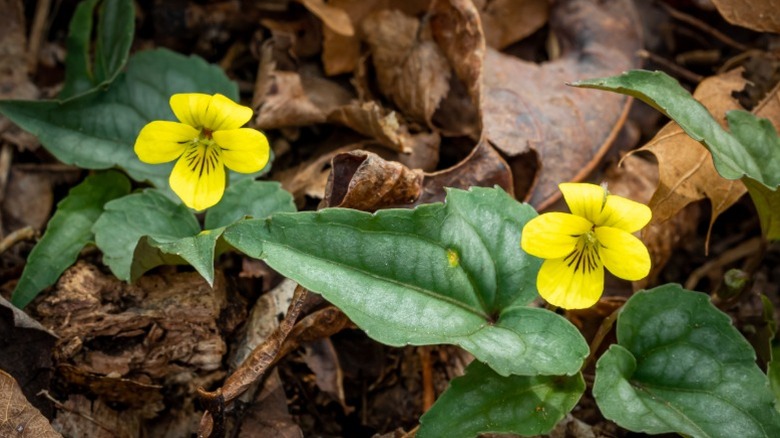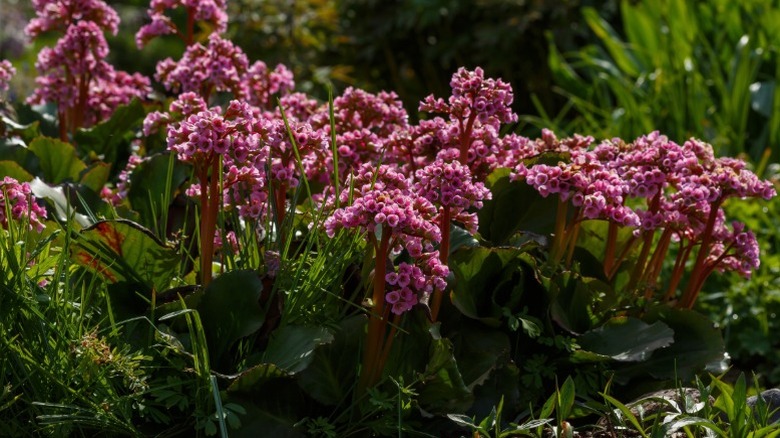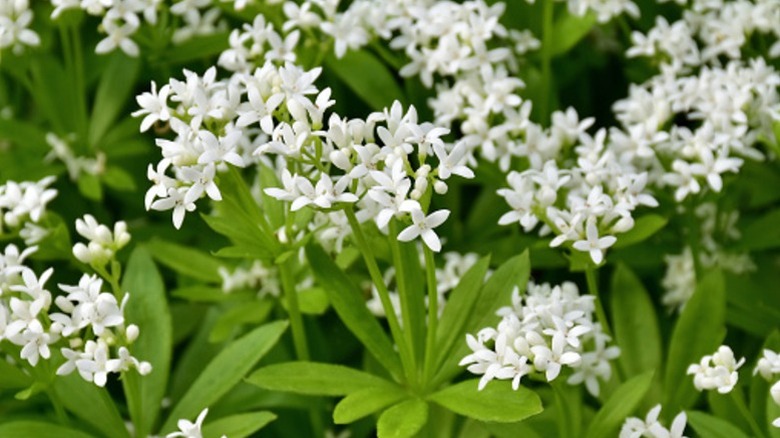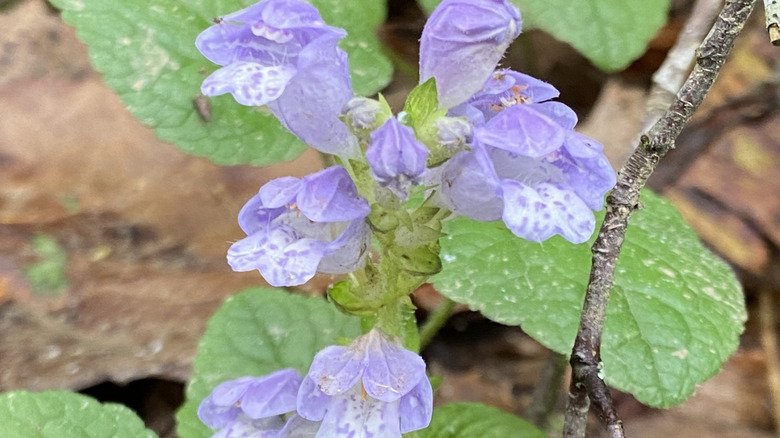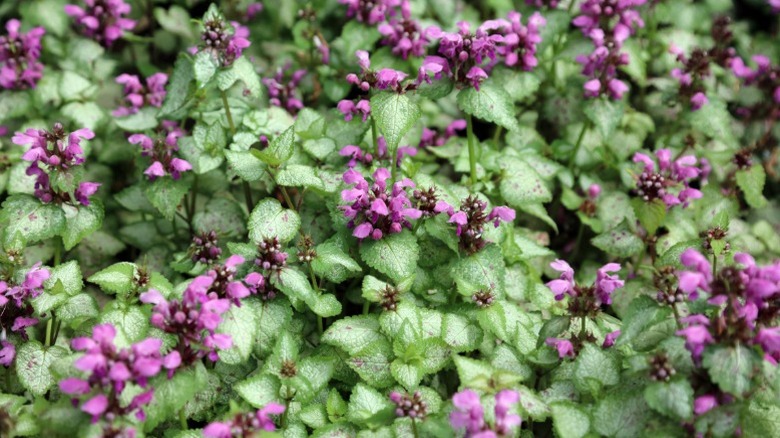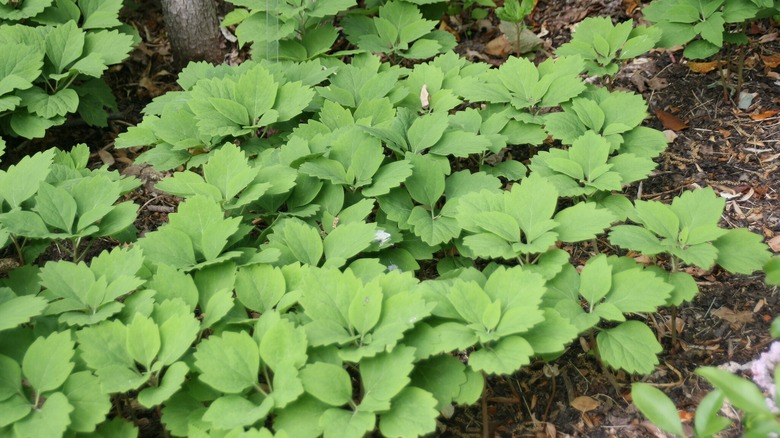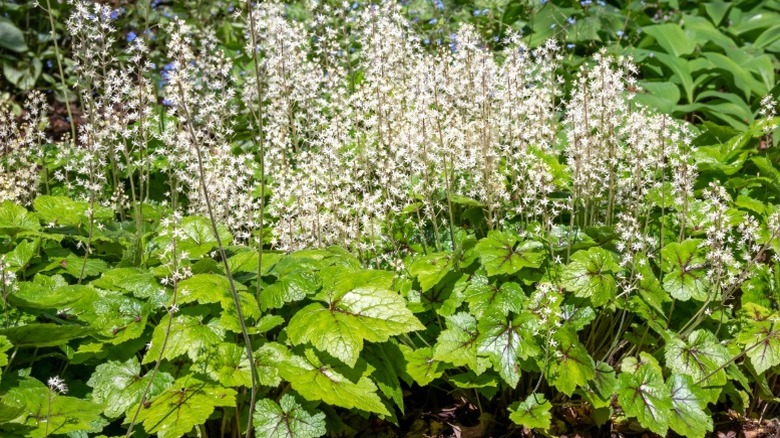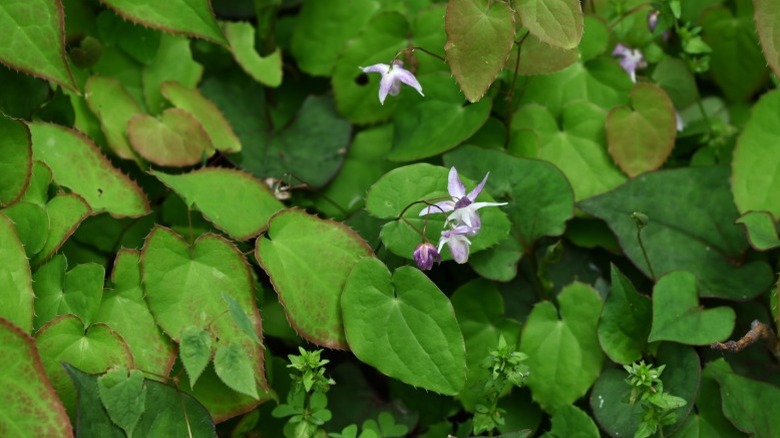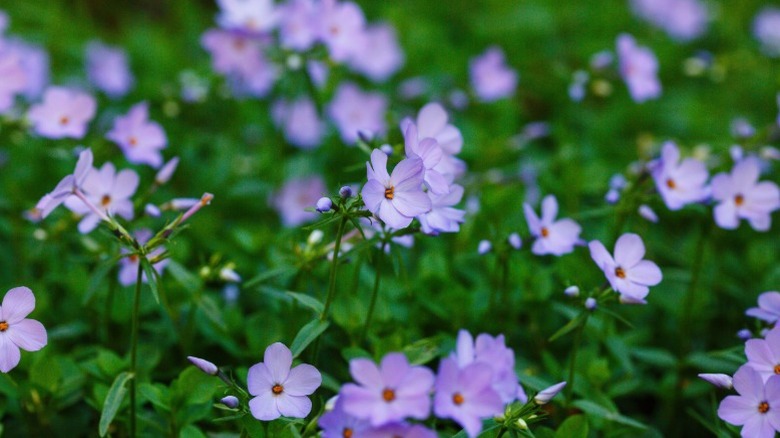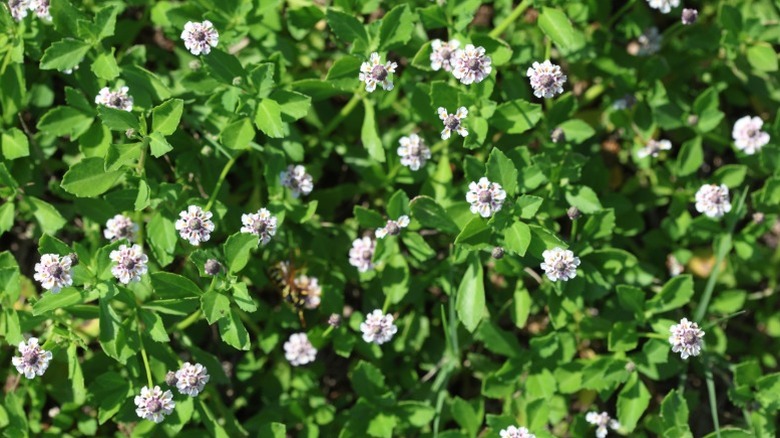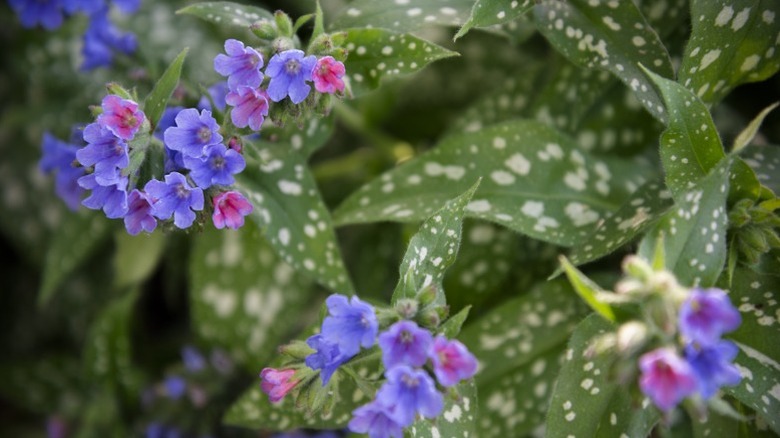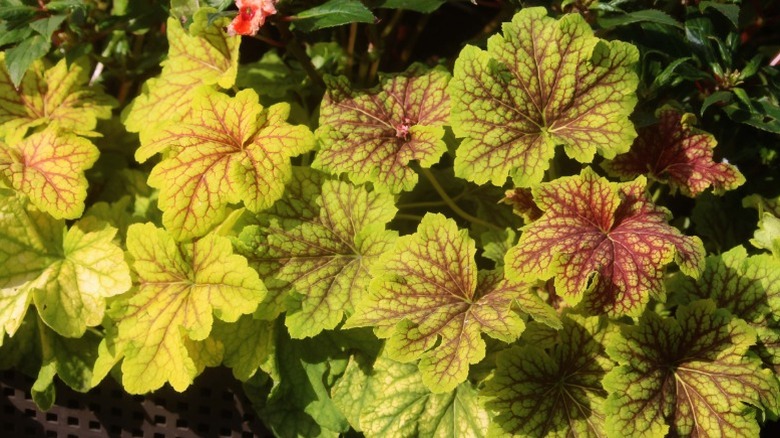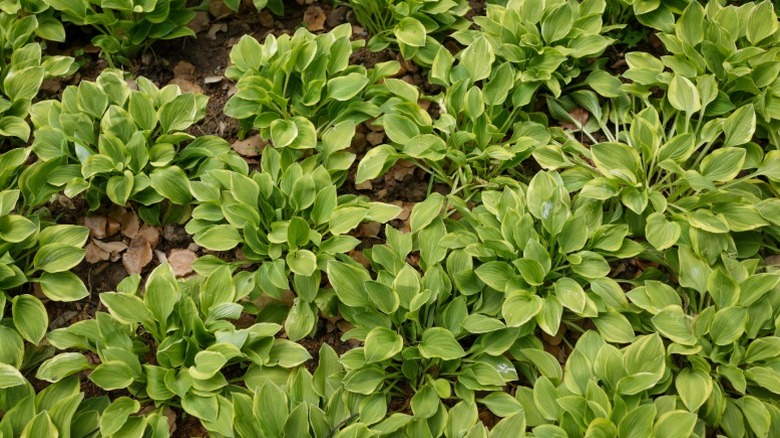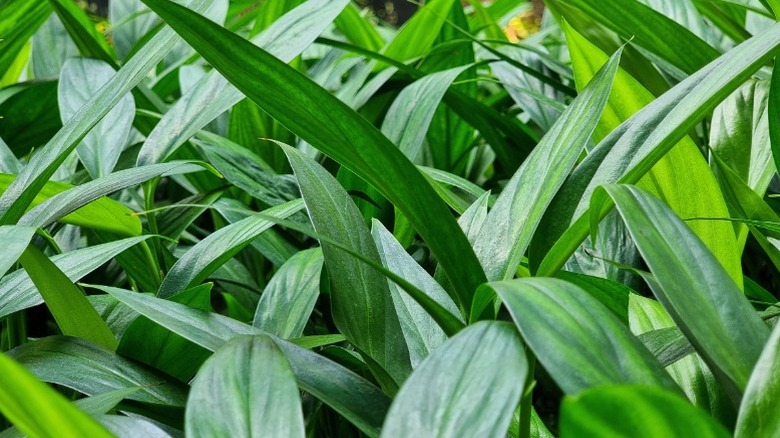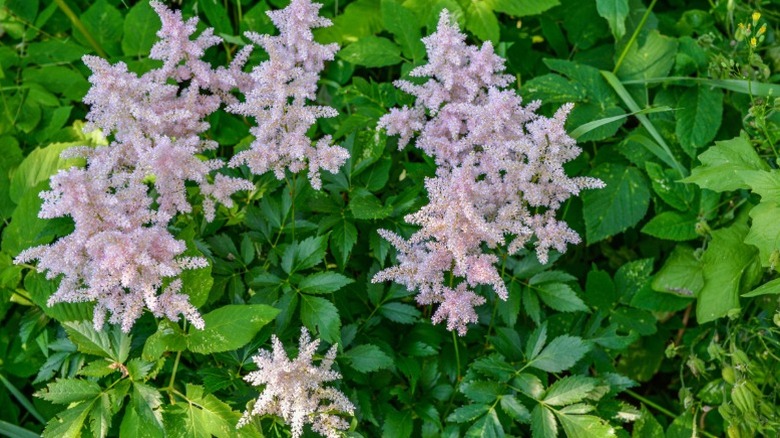18 Ground Covers That Thrive In The Shade And Add Beauty To A Garden
Just because you are planting in the shade, it does not mean that you want boring or drab ground cover. While it can be a unique challenge, growing in shaded areas will add beauty and life to all areas of your garden. There are many gorgeous ground cover plants that love shade that can brighten up the shadows of your lawn. From pretty pink sprays of astilbe blooms to lush green hosta leaves, there is a ground cover option to match the theme of your garden.
What works in sunnier parts of your yard will not work for shade. Most common turfgrass species struggle to grow in any kind of consistent shade, leaving bare roots or unsightly, scraggly coverage. Beyond being an eyesore, sparsely-covered soil can turn into a real problem. Without vegetation, your landscape can be at risk of erosion and susceptible to weedy invaders. Prioritize ground covers that thrive in shade to avoid these long-term issues and bring a little unique flair to your shady spots.
Create a mat of lively green and gold foliage
A cheerful ground cover that looks just like its common name, green and gold (Chrysogonum virginianum) grows low across the landscape, forming a mat of foliage. Native to the eastern part of the U.S., this species is also known as golden star thanks to its yellow, star-shaped flowers. In its natural habitat, this species thrives in shady woodlands, so it easily establishes itself in shady parts of your lawn. Green and gold is hardy in zones 5 through 9. For the best ground cover, opt for the southern or central varieties, which grow via stolons.
Grace your lawn with the red berries of American wintergreen
Add beauty to the shade in any season with American wintergreen (Gaultheria procumbens), also known as checkerberry and teaberry. Native to hardwood forests, this creeping perennial in the blueberry family grows well even in deep shade. An evergreen, it features aromatic berries and leaves and blooms with white flowers in late summer. It makes a good ground cover due to spreading lowly over the ground. And no matter which season, it proves stunning, with evergreen foliage year-round, flowers in the summer, and berries in the winter. Grow in hardiness zones 3 through 7.
Establish a bed of Canadian wild ginger for erosion control
Native to both Canada and the United States, Canadian wild ginger (Asarum canadense) can absolutely flourish in deep shade. Highly tolerant of erosion and wet soils, plant this slow-growing wildflower in moist, shaded areas of your yard. Along with being a rain tolerant ground cover that can help soak up extra rain, wild ginger will have pollinators coming to your yard. It flowers prettily in spring with small red-maroon blooms peaking out of its heart-shaped leaves. Hardy from zone 4 to 6, wild ginger is a slow-growing, but steady, ground cover.
Give your lawn texture with spiky halberd-leaf violet
A native wildflower with tolerance for full sun or deep shade, halberd-leaf violet (Viola hastata), or spearleaf violet, grows only to 1 foot tall. Halberd-leaf violet prefers moist, acidic soil. While it tolerates dryness, it won't tolerate heat. Characterized by green leaves that taper to a point like little swords, this perennial also blooms with tiny yellow butterfly and bee-attracting flowers in springtime. Its easy spreading ability and lively colors make it popular as a ground cover. Plus, hungry deer will not ruin it. This species of violet is hardy from zones 5 to 8.
Showcase pink blooms in your shade garden
A whimsical ground cover selection, bergenia (Bergenia crassifolia) grows less than 2 feet tall and requires little maintenance. Another of its common names is pigsqueak from the sound resulting from rubbing its leaves. A slow-spreading species, you can plant it in your shade garden without worrying about overgrowth. Thriving in partial to full shade, this evergreen blooms in early spring en masse in tall stalks that rise above the foliage. Bergenia is hardy in zones 3 through 8, being native to forest and alpine regions in China and Siberia, but it can be damaged by severe winter weather.
Fill your garden with inviting, odorous greenery
Although it's not native to the U.S., the fragrant sweet woodruff (Galium odoratum) is an ideal ground cover for shady outdoor spaces. This perennial, also called bedstraw, has a spreading habit thanks to rhizomes that helps establish a nice blanket of evergreen foliage with white, star-shaped flowers in early spring. Sweet woodruff adds a pleasant scent that's a mixture between grass and vanilla. It is hardy in zones 4 through 8 and grows 1 foot tall. Keep it from becoming aggressive by propagating it in cooler, shady areas with clay soil, which helps limit its spread.
Plant a showy native for its pretty floral display
Growing Meehan's mint (Meehania cordata) is ideal if you want a blue-flowering ground cover in your shade garden. This native develops lavender blue flowers in the late spring that push up above the green leaves of this low-lying (3 to 6 inches tall) species. Also known as heartleaf meehania, it has great tolerance for shade, even tolerating heavy shade without problems. Plant this spreading perennial in hardiness zones 4 through 8. Offer moist, well-drained soil and this plant will cover your space slowly and never aggressively.
Use this easy spreader for shady ground cover
A low-growing and spreading species, spotted deadnettle (Lamium maculatum) grows quickly. Named after nettle, it's a "dead" version because it lacks the stinging power of true nettle. Not only does it thrive in shaded conditions, this herbaceous perennial adds a touch of color to your garden with beautiful and bright flowers adorning it from late spring to autumn. This plant is best grown in zones 3 through 8, but make sure it's not considered invasive in your area before planting.
A pretty and noninvasive native spurge for ground cover
A lot of pachysandra species get a bad name in the U.S. thanks to invasive issues associated with nonnative plants. However, Allegheny spurge (Pachysandra procumbens) or mountain pachysandra, is a eastern native with beautiful coloring. Unlike invasive pachysandra, Allegheny spurge spreads into dense ground cover without overtaking your garden. Plant it in dappled sunlight, partial shade, or deep shade and provide consistent moisture for the best results. In early spring you are rewarded with tall stalks of purple and white flowers. Hardy south of zone 6, it remains evergreen to semi-evergreen in zones 7 and 8.
Slow-growing foamflower lends elegance to shady gardens
A native wildflower to the U.S., foamflower (Tiarella cordifolia) can be found in the wild in woodlands. Use as ground cover to take advantage of its means of growth via stolons beneath the soil. It will fill in parts of your garden that do not receive much light, preferring partial to full shade. Plant in hardiness zones 4 to 9 and provide moist and enriched soil. The show stopping flowers that help give foamflower their name arrive sometime in spring. These cloud-like sprays of pink and white hover above the deeply lobed leaves.
Show love to your shade garden with heart-shaped barrenwort
A low-growing, clump-forming species, barrenwort (Epimedium spp.) makes a beautiful ground cover for shaded areas. There are a variety of cultivars, with a range of exciting leaf and flower colors. Sometimes called fairy wings, most plants in this genus feature unique four-petaled flowers with an arching shape. Barrenwort plants are typically hardy in zones 5 through 8, and are non-native with origins in China and the Mediterranean. Use it in shaded areas to take advantage of its disease tolerance and deer resistance. When not flowering (which occurs from May to June), barrenwort displays charming heart-shaped leaves.
Add a little color to your dark areas with creeping phlox
A native which grows in loose mats of pretty spoon-shaped foliage, creeping phlox (Phlox stolonifera) is common in the Appalachian mountains. When grown as ground cover, it combines beauty with utility. Thriving in shade, creeping phlox is ideal if you want a species that can withstand light foot traffic. Along with being easy-to-grow in shade, hummingbirds and butterflies will flock to your yard for this colorful ground cover plant. In April and May, creeping phlox blooms in various shades, including blue-violet or rosy-lavender. It is hardy in zones 5 through 8.
A southern native with butterfly-attracting flowers
Frog fruit (Phyla nodiflora) might have a strange name, but there's nothing wrong with this fun turfgrass alternative. Native to the southern U.S., it's sometimes considered weedy due to its tendency to creep into poorly watered lawns. However, frog fruit (sometimes called turkey tangle fogfruit) can be used as a thriving ground cover for a wide range of spaces. It grows well in partial shade and tolerates drought, wind, and most types of soil. Its small purplish, verbena-like flowers catch the eye when planted together and their nectar attracts butterflies. Hardy in zones 6 through 11.
Magical color-changing lungwort is a bold shade plant
A perennial ground cover option, lungwort (Pulmonaria officinalis) is fairly low-growing, reaching only about 10 inches tall. This European native is a member of the borage family and grows slowly so it is not a threat to native plant life. Lungwort will form spreading clumps that fill in spaces neatly. Bring your shade garden to life with the funnel-shaped flowers of lungwort, which change colors as they mature. However, even the leaves are beautiful, with some showcasing silver or white spots. Plant lungwort primarily in hardiness zones 5 to 9, although some species may be hardier.
American alumroot offers showy ground cover for any season
With unique flower stalks that rise up from the green foliage below, American alumroot (Heuchera americana) is a stunning ground cover. At the end of these wildflower's stalks, tiny greenish-purple flowers droop down. These bell-shaped flowers attract different pollinators and the species will thrive in shady areas. In the fall, after flowering is over, the leaves offer a pretty presentation by changing to yellow, purple, and red. American alumroot will add a touch of color to your shade garden and will even tolerate periods of drought. It is hardy in zones 4 through 9.
A lush and bold ground cover with brilliant green colors
For a lush, low-maintenance ground cover that thrives in the shade, hostas spread easily. With over 2000 cultivars, hostas make a great mass planting option, especially when considering the species that grow via underground stems. You can plant a few hostas and they will naturally fill out a space. Opt for cultivars with blue-green leaves, which thrive especially well in shade. Focus on varieties marked as ground cover, like 'Gold Drop' with pretty green-yellow leaves that does not get taller than 1 foot. Hostas are typically hardy in zones 3 to 9.
Substitute this species for hostas as ground cover
This evergreen species not only thrives in shade, its best planted away from the sun. Cast iron plant (Aspidistra elatior) is often grown as a houseplant, but it makes a flashy ground cover with its long and leathery leaves. Also called bar room plant, it easily spreads in ideal conditions via rhizomes to form large and attractive mounds of foliage up to 3 feet high. Cast iron plant is hardy in zones 7 through 11 and is native to Asia but is not invasive. Consider planting the 'Asahi' variety for its pale green leaves with white tips.
Grow a cotton candy-like floral ground cover
Requiring partial to full shade, astilbe are unique flowering plants with incredible potential as a shady ground cover. Typically smaller perennials, most astilbe grow under 2 feet tall and have a clumping habit. Ovular astilbe leaves come in bronze, green, or red, but the flowers steal the show with plume-like stalks rising straight out of the foliage. Colors of flowers range from white to lavender to red. Mixing species can give your ground cover more beauty throughout the entire growing season. Astilbe is hardy from zones 3 to 9 and prefers moist, rich soil.
